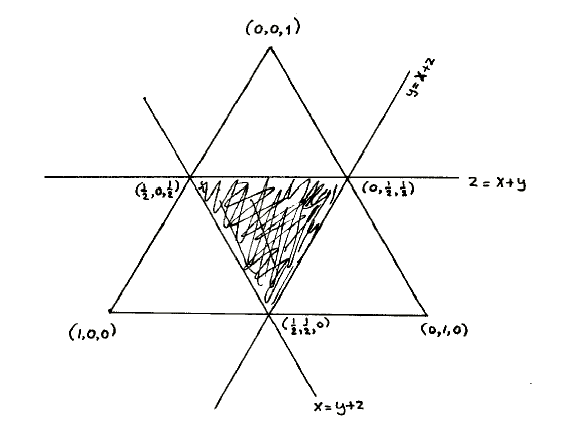Mathematics in an easy chair.
This afternoon W.H.J.Feijen posed me the following problem. Take a circular piece of string -- of length 1, say -- and select three times a random point of the string. Ignoring the case of coincident points -- which has a probability = 0 -- we get three pieces of string when we cut the string at the tree points chosen. How large is the probability that, stretched, these three pieces could form a triangle, or, more precisely, if the lengths are called x, y, and z respectively, how large is the probability that the three inequalities x ≤ y + z, y ≤ z + x, and z ≤ x + y are satisfied? Could I think of a simple argument that would not destroy the symmetry of the problem statement?
I thought about the problem in an easy chair in the living room, while enjoying a glass of sherry before dinner. The answer is 1/4, and here is my argument.
To every choice of three points we can assign uniquely three values x, y and z : we take them, for instance, in the clockwise direction, starting with the first point chosen. Hence, for any value of z, the value x is drawn homogeneously from 0 to 1 - z . For any set of values we can plot in a three-dimensional space with three rectangular coordinates the point (x, y, z); all these points lie in the plane with equation x + y + z = 1, more precisely within the equilateral triangle with vertices (1,0,0), (0,1,0), and (0,0,1) respectively. Because for fixed z --see above-- x is drawn homogeneously from 0 to 1 - z , the probability density is in this triangle constant along a line parallel to its side in the (x,y)-plane. For reasons of symmetry the probability density is constant along a line parallel to any of its three sides, and, hence, the probability density is constant over the whole triangle. The required probability is therefore the area of the triangle satisfying the three inequalities divided by the area of the whole triangle. As the plane x = y + z cuts the triangle in the midpoints of two of its sides --viz. (.5,.5,0) and (.5,0,.5)-- and the interior of the little triangle corresponds to the points satisfying the triangular inequalities, the probability sought equals 1/4.

The above should not be interpreted as a recommendation for drinking a glass of sherry before dinner. The circumstances under which I found the above solution have, however been recorded as they form the N-th confirmation (N large) of the experience that postponing the use of pencil and paper is very helpful in finding a simple solution (if there is one, of course). If I had a Thinking School, my students would have their hands tied behind their back!
Finding the above solution took about ten minutes
18 December 1978
Plataanstraat 5 |
prof.dr.Edsger W.Dijkstra |
Transcription by Joel Hockey
Last revised on